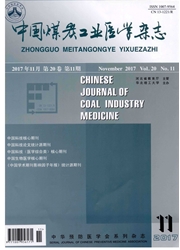

 中文摘要:
中文摘要:
目的探讨结缔组织生长因子(connective tissue growth factor,CTGF)和皿型前肢原氨基末端肽(N-terminal procoLlagen peptide-Ⅲ,PⅢNP)在接尘工人血清中表迭水平的变化及其意义。方法采用双抗体夹心法测定72例煤矿接尘工人(分为O+组32例与接尘组40例)和45例健康对照者血清CTGF、PⅢNP的表迭水平。结果O-组血清CTGF和PⅢNP含量分别为(132.16±5.11)pg/ml、(10.99±0.87)ng/ml,接尘组则分别为(102.99±3.71)pg/ml、(9.14±1.11)ng/ml,对照组为(27.89±2.22)pg/ml、(8.02±1.09)ng/ml。0+组、接尘组血清CTGF含量均高于对照组,差异有统计学意义(P〈0.05),0+组与接尘组差异亦有统计学意义,O’纽与接尘组按工龄分层,各层之间差异有统计学意义,随着接尘工龄的增大,血清CTGF水平亦增高。而血清PⅢNP在各纽闻的差异均无统计学意义。结论本次研究提示CTGF可以做为监测粉尘暴露的指标,PⅢNP在各组间水平无明显变化,提示PⅢNP不是反映粉尘暴露的灵敏指标。
 英文摘要:
英文摘要:
Objective To explore the level and significance of CTGF , PⅢNP in the serum of dust exposed workers. Methods The serum levels of CTGF,Pill NP in 72 dust exposed workers (including 32 people in 0+ group and 40 people in dust exposed group) and 45 healthy individuals were detected by means of enzyme linked immunosorbent assay (ELISA). Results The serum levels of CTGF ,PⅢNP in 0+ group were(132.16±5.11)pg/ml,(10.99±0.87)ng/ml and which in dust exposed group were (102.99±3.71)pg/ml,(9.14±1.11)ng/ml, the serum levels of control group were (27.89±2.22) pg/ml, (8.02±1.09) ng/ml. There were statistically difference of CTGF level among the three groups(P〈0.05) ,the serum levels of CTGF in 0+ group were higher than those in the dust exposed group and control group. There were no statistically difference of PⅢNP in the three groups(P〉0.05). Conclusion The serum levels of CTGF can be used as a sensitive sign of dust exposure. The serum levels of Pill NP in dust exposed workers might not be a sensitive sign of dust-exposure.
 同期刊论文项目
同期刊论文项目
 同项目期刊论文
同项目期刊论文
 期刊信息
期刊信息
